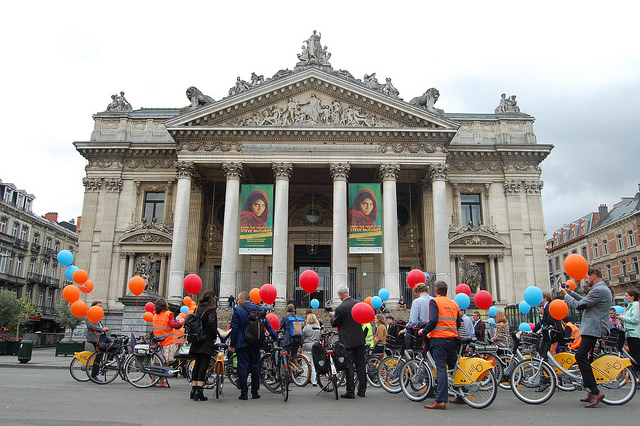
The Commission’s response to the EU Cycling Strategy: ‘We will land the cycling strategy as part of the 2018 initiative on multimodality’
120 participants talked and practiced cycling at the Big Bike Event, jointly organised by the transport teams of the Permanent Representations of the three Benelux countries to the EU. ECF’s key message at that event: “Achieving a level-playing field for cycling will deliver more people cycle more often.” The Commissions response: We will land the cycling strategy as part of the 2018 initiative on multimodality.
After the EU Cycling Strategy was officially published and handed over to EU Commissioner Violeta Bulc at the Velo-city conference two weeks ago in Arnhem-Nijmegen, the Big Bike Event yesterday was the excellent occasion to introduce the cycling strategy to the Brussels audience.
One of the key messages of the Velo-city conference was: cycling means happiness. And Dutch children belong to the happiest on earth, Mark Frequin, Director-General for Transport and Mobility at the Dutch Ministry of Infrastructure and Environment and yesterday’s moderator, said in his opening words of the event’s Seminar.
The Dutch Ambassador to Belgium, Maryem van den Heuvel, illustrated to what extend cycling is in the DNA of the Dutch society: “Dutch children start cycling at the age of three and cycle to school at the age of four”, she said.
Picking up that point, 10 years ago, there was no cycling culture in Luxembourg left, except sports cycling, François Bausch, Transport Minister in Luxembourg, reflected. “But from a mere 0.5 % cycling mode share in Luxembourg City we went up to a respectable 6 % today”, illustrating that a change in mobility is possible. Being the ‘father’ of the 2015 Luxembourg Declaration on Cycling that called for a ‘EU level strategic document on cycling’, Bausch was strongly supported by his Belgian colleague, François Bellot. “Cycling means jobs, better air quality, less congestion”, he argued.
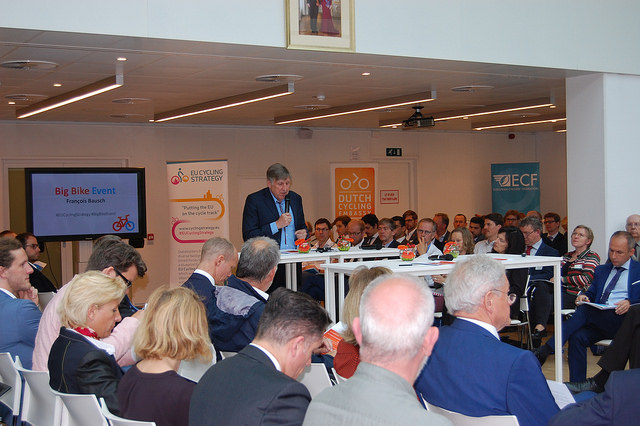
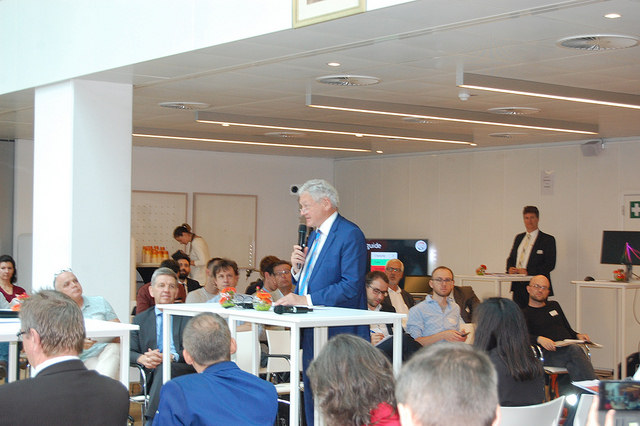
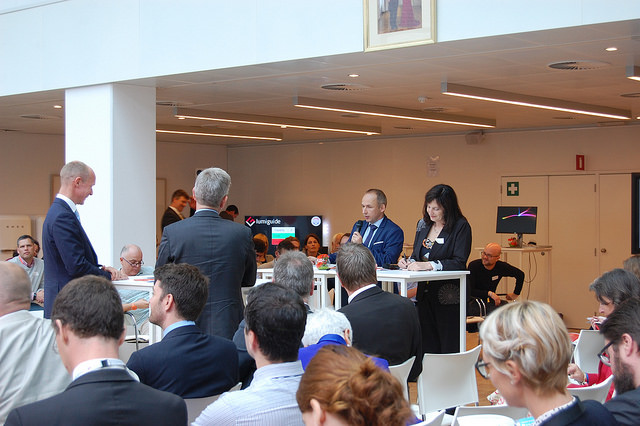
Adam Bodor, ECF’s Advocacy Director, fed these arguments with concrete figures. The economic benefits of cycling are € 513 billion creating 650,000 jobs in the EU. If cycle use increased by 50 % by 2030, these numbers would jump to € 760 billion and 875,000 respectively. But cycle use will only increase accordingly if a level playing field for cycling as a means of transportation will be created, Bodor said. As a concrete measure, the EU Cycling Strategy, among many other, suggests to increase EU investments into cycle projects from the current € 1.5 billion in the period 2014 – 2020 to € 3 billion in the period 2021 – 2027.
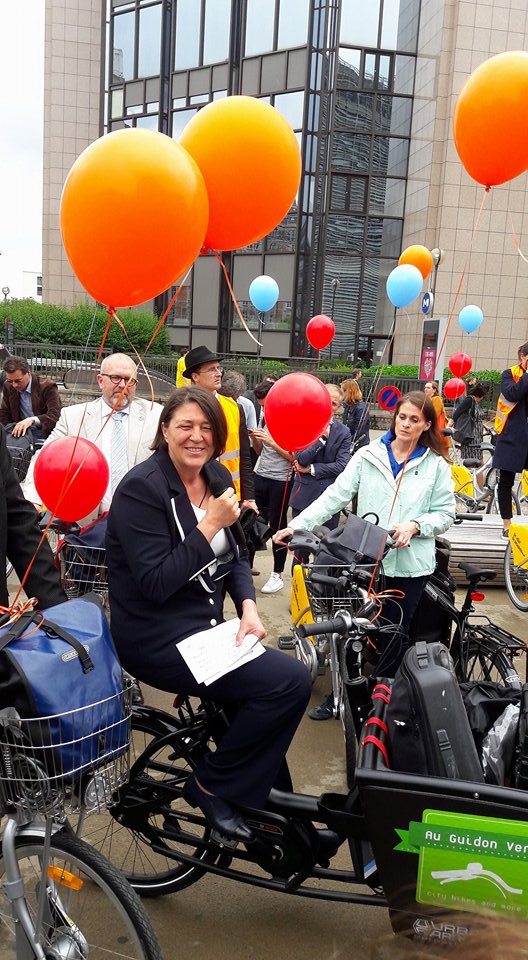
Herald Ruijters, Director Investment, Innovative and Sustainable Transport at the Commissions DG MOVE promised to analyse the EU Cycling Strategy’s recommendations very carefully and announced that 2018 will be the year of Multimodality. “There we will be landing with the Cycling Strategy”, he announced. Ruijters also stressed that EU funding needs guidance, such as provided through the Sustainable Urban Mobility Plans.
That view was shared by Ruth Oldenziel, Professor at the History Division of Technology Innovation at Eindhoven University. “Cycling policy is more successful if embedded in a wider transport strategy”, she said. Talking history, she referred to the year 1926 when a first manifesto calling for a mobility system centred around the car was published, at a time when car usage in Europe was only something for the happy few before mass motorisation took off from the 1950s onwards. But there is no reason to be pessimistic: “We are for national cycling policies now where we were for the car in 1926”, Oldenziel said.
Raymond Gense from Pon, one of the largest bicycle manufacturing company in the world as well as VW importer in the Netherlands, also struck a positive note, by pointing out that the bicycle industry is reinventing itself. “In 3 to 5 years, all bicycles entering the market will be connected”, he claimed, hereby integrating the bicycle into the mobility system.
The potential for cycling mobility looks bright, but Minister Bausch rightly pointed to one of the main barriers: “The bicycle as a transport solution is such a low hanging fruit, politicians can't even see it from their cars."
So the event participants took to the start of the bike parade to Schuman Roundabout where they were addressed by Violeta Bulc: “I'll do my part to take cycling on board of the mobility solutions", she promised.
 The bike parade stopped at the European Parliament where ECF Secretary General, Bernhard Ensink, handed over the EU Cycling Strategy to Members of European Parliament Georges Bach, Michael Cramer and Claude Turmes, thanking them for their support to put cycling on the agenda of the European Union.
The bike parade stopped at the European Parliament where ECF Secretary General, Bernhard Ensink, handed over the EU Cycling Strategy to Members of European Parliament Georges Bach, Michael Cramer and Claude Turmes, thanking them for their support to put cycling on the agenda of the European Union.
Guiding the bike parade, Pascal Smet, the Brussels Minister for Mobility and Public Works, talked with much passion about the projects achieved so far and the many projects that still await completion in the coming years. Brussels represents a city par excellence that embraced the automobile era. “Not anymore”, he said. “My vision for Brussels is one of people, not of cars.”
The story of Brussels embracing a paradigm shift could well symbolise a tipping point for European cities embracing a new mobility culture. The EU Cycling Strategy provides much guidance of how the EU can become an even stronger partner in this process.
For more photos from the Big Bike Event click here.
Contact the author
Recent news!
Upcoming events
Contact Us
Avenue des Arts, 7-8
Postal address: Rue de la Charité, 22
1210 Brussels, Belgium









